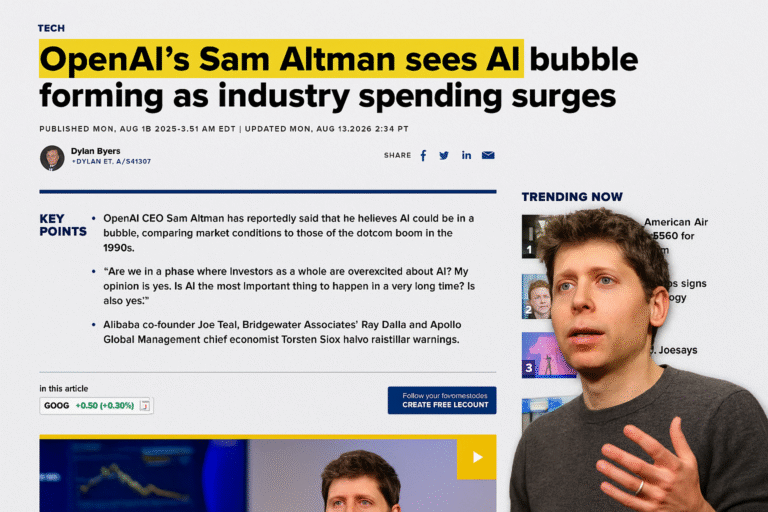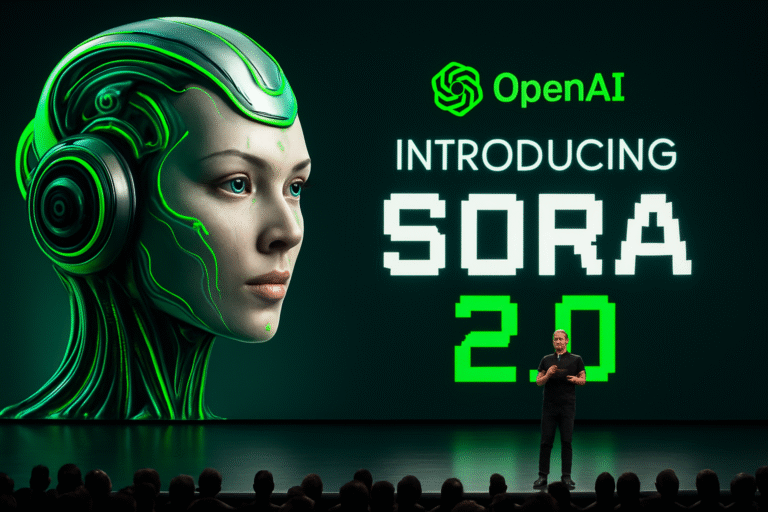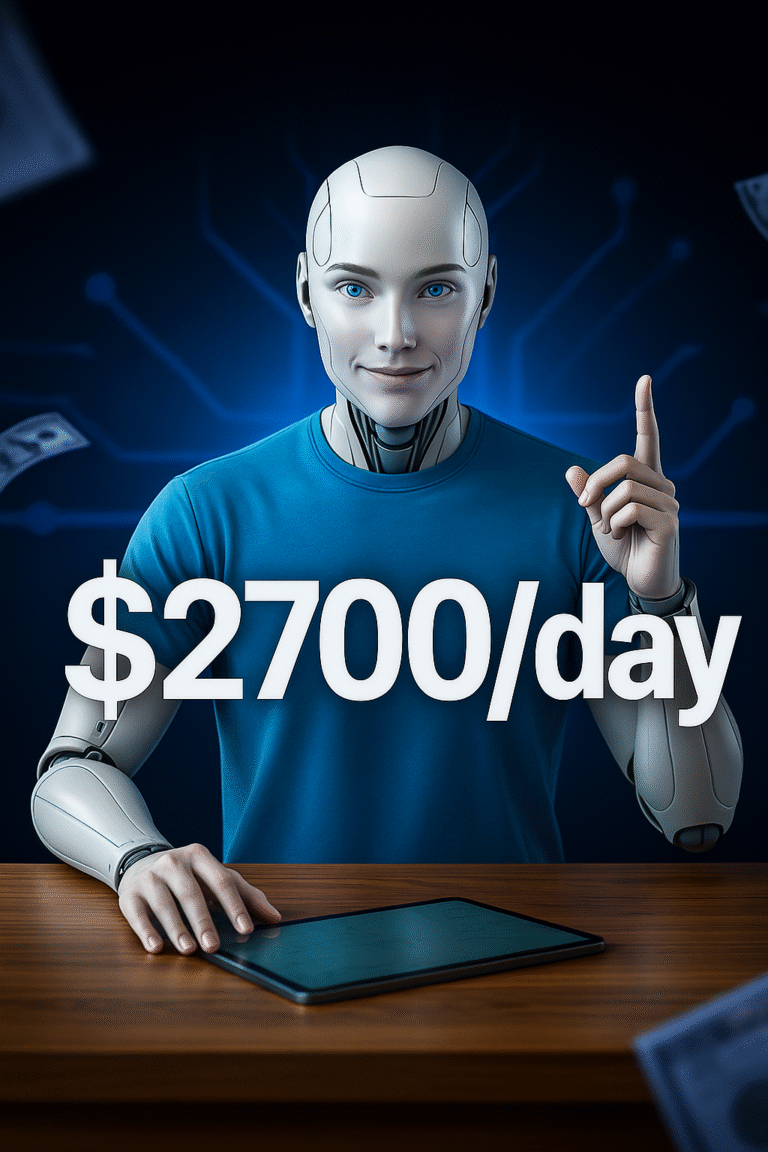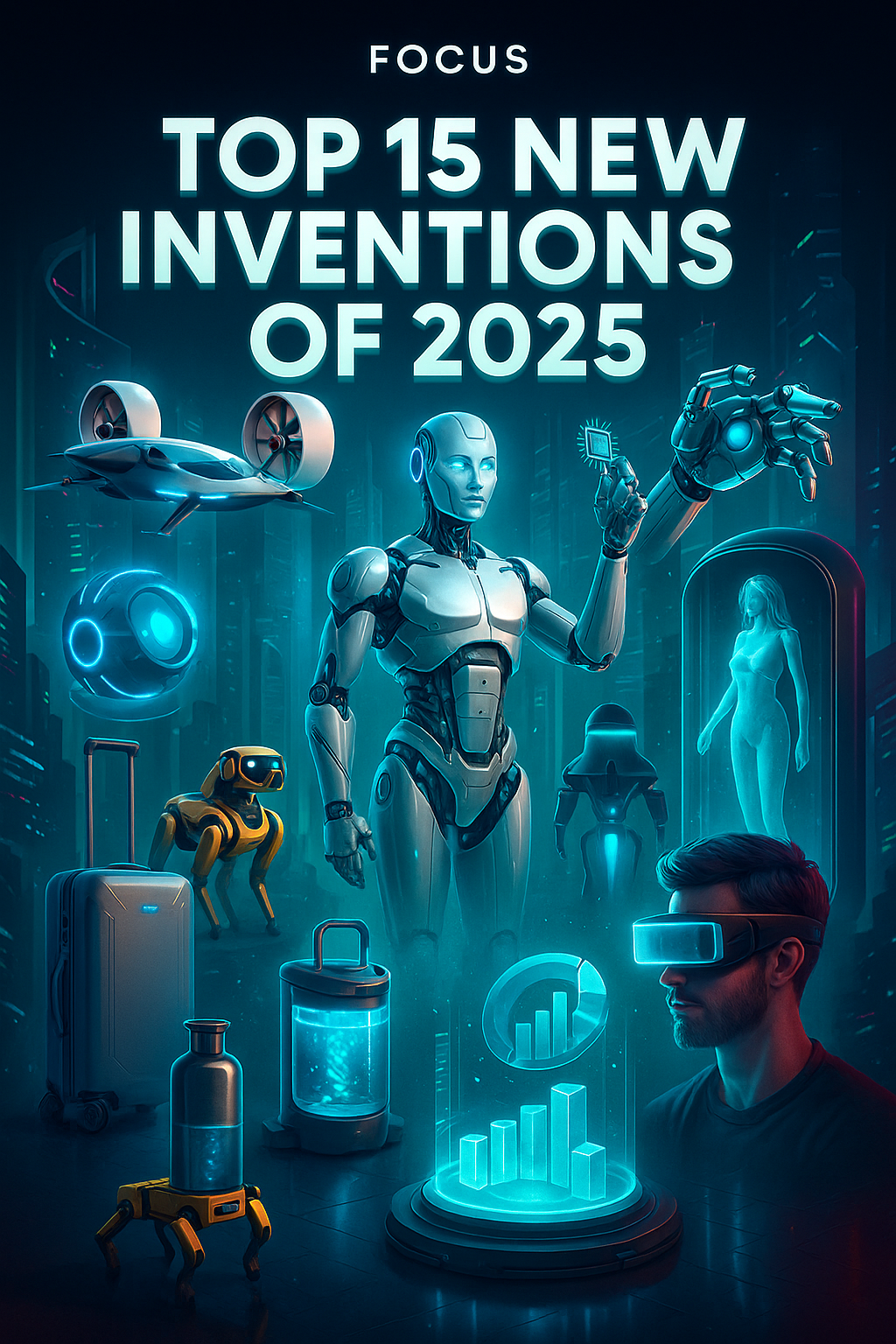
Introduction: The Future Is Happening Now
What if the world of 2040 isn’t decades away — but already here?
Technology in 2025 is advancing at lightning speed, blurring the line between science fiction and everyday reality. From smart contact lenses that overlay digital data on your vision to quantum computers breaking performance barriers, innovation is rewriting the rules of life as we know it.
In this article, we count down the Top 15 New Inventions of 2025 that make today feel like tomorrow. Let’s dive into the future that’s already unfolding around us.
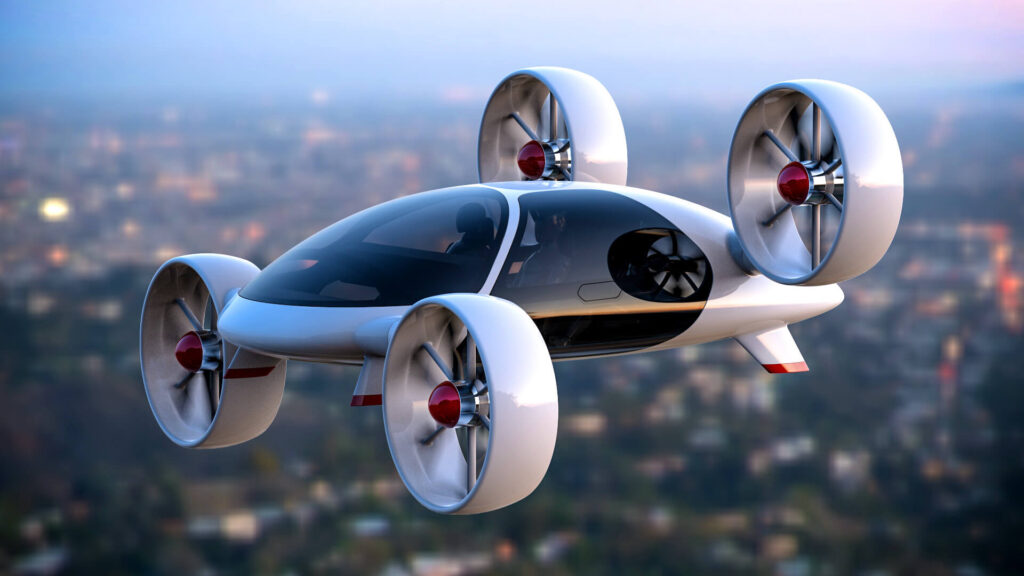
1. Smart Contact Lenses — The Eye Interface Revolution
Imagine checking flight updates or receiving health alerts right through your vision. That’s what smart contact lenses promise — a wearable digital interface that turns your eyes into screens.
How Smart Contact Lenses Work
Startups like Expansio, backed by $250 million in funding, are developing lenses capable of AR overlays, zooming, and health monitoring using tear fluid sensors. Similar prototypes from Mojo Vision and South Korean research labs already display basic text and track glucose levels.
Real-World Use Cases and Health Integration
By 2027, business-focused versions are expected to launch, potentially replacing bulky headsets and even smartphones. This invention merges health tech, AI, and optics to redefine human-computer interaction — a leap that makes 2025 feel like 2040.
2. Biodegradable Electronics — Sustainable Tech at Its Best
Tech waste is a growing concern, but biodegradable electronics are here to change that.
How Biodegradable Gadgets Break Down Naturally
Researchers at Seoul National University have created conductive fibers that maintain high performance yet decompose in soil within months. They combine durability with sustainability — a rare feat in modern electronics.
The Future of Eco-Friendly Tech
Analysts forecast this market to skyrocket from $1.15 billion in 2025 to $12.88 billion by 2032. Imagine wearable sensors that vanish after use — no landfill, no trace, just innovation in harmony with nature.
3. Digital Twins of Organizations — The Virtual Business Revolution
Behind every great company, there’s now a digital twin — a full-scale virtual replica that mirrors operations, supply chains, and systems.
How Companies Are Using DTOs for Efficiency
Tech giants like Siemens, Microsoft, and Accenture are pioneering this space, using simulations to predict failures and test scenarios before implementing them in real life.
Benefits and Future Applications
These digital twins allow leaders to visualize performance and optimize resources in real time, reducing costs and enhancing foresight.
4. Ambient Invisible Intelligence — The Rise of Predictive Environments
The next era of AI isn’t loud or flashy — it’s invisible.
Ambient Invisible Intelligence describes systems that work quietly in the background, predicting user needs before they’re even expressed.
AI That Anticipates Human Needs
From smart homes that adjust temperature and lighting automatically to hospitals where AI algorithms detect patient health issues early, this form of intelligence is reshaping how humans and machines interact. It’s proactive, not reactive.
Applications in Healthcare and Smart Homes
Hospitals using predictive AI have already seen up to 20% fewer ICU complications, while the global smart building market is projected to exceed $570 billion by 2030. The promise? Environments that adapt to you — seamlessly, silently, intelligently.
5. Post-Quantum Cryptography — Securing the Digital Future
Quantum computers could soon crack today’s encryption in hours, posing a major cybersecurity threat.
That’s why Post-Quantum Cryptography (PQC) is among the Top 15 New Inventions reshaping digital safety.
The Quantum Threat to Current Encryption
Traditional cryptography relies on problems too complex for classical computers — but not for quantum machines. To protect future communications, researchers are developing encryption that even quantum algorithms can’t break.
The New Security Standards of 2025
In 2025, NIST finalized its first three PQC standards, plus a new code-based algorithm called HQC. These standards are already being integrated into federal systems, ensuring the world’s digital defenses are quantum-proof.
👉 Learn more about PQC from NIST’s official documentation.
6. Immersive VR 2.0 and AR — The Next Reality Leap
Virtual Reality (VR) and Augmented Reality (AR) have matured into powerful tools, driving the next leap in media, training, and education.
How AR and VR Are Changing Everyday Life
Companies like Snap, Unity, and XRE are pioneering immersive experiences that go beyond gaming. In 2025, news networks are already broadcasting using AR overlays and VR studios that blend anchors with holograms.
Real-World Industry Examples
In education, students can now explore historical sites in VR, while surgeons use AR-assisted overlays during operations. What began as entertainment is now a core part of modern learning and communication.
7. AI-Powered Personal Assistants — Smarter Than Ever
Personal assistants have evolved far beyond reminders and playlists.
The Rise of Generative AI in Homes and Offices
In 2025, Amazon’s Alexa Plus and Apple’s upgraded Siri are redefining convenience. These assistants can book transport, manage tasks, plan meals, and even personalize study schedules — all autonomously.
What’s Coming Next for AI Assistants
Soon, your AI assistant won’t just follow orders — it’ll predict what you need before you ask. By 2026, experts predict assistants will become fully proactive digital companions, integrated across every device.
8. Hybrid Computing — Merging Cloud, Edge, and Quantum
In 2025, hybrid computing has become the ultimate solution to handle massive data processing efficiently.
How Hybrid Systems Improve Efficiency
Rather than choosing between cloud or edge computing, companies now use both, blending AI and quantum systems for optimal performance. Data flows seamlessly between layers based on need and speed.
Real Industry Implementations
Tech giants like Microsoft are testing quantum-ready hybrid apps, while manufacturers use this setup for real-time production analytics. It’s not just faster computing — it’s intelligent computing.
9. Synthetic Media and AI Influencers — The New Faces of Marketing
Welcome to a world where your favorite online personality might not even exist.
How AI-Generated Influencers Work
AI-generated influencers like Lil Miquela or Vodafone’s AI TikTok presenter can interact, promote products, and even deliver speeches. In 2025, synthetic media has become a mainstream marketing tool.
Ethical Concerns and Market Growth
While this tech raises ethical questions about transparency, it’s growing fast — the virtual influencer market is expected to surpass $21 billion by 2030, with healthcare, fashion, and tech brands leading adoption.
10. Hyperloop Transportation — Speed Redefined
Hyperloop systems are making rapid progress toward becoming a real-world transport network.
The Latest Hyperloop Achievements
In 2025, a Dutch startup achieved successful high-speed switching at 700 km/h, while India’s freight-focused Hyperloop project is connecting two major ports — the first step toward mass adoption.
The Path Toward Passenger Travel
Though passenger routes aren’t ready yet, once cargo Hyperloops prove viable, urban-to-urban passenger systems could follow within a decade — cutting travel times by 80%.
11. 3D Bioprinting Organs — The Medical Frontier
The future of medicine lies in 3D bioprinting — where human tissues are printed layer by layer.
How 3D Printing Is Saving Lives
Scientists can now print skin, cartilage, and miniature heart models for surgical testing. In early 2025, the FDA granted breakthrough status to a bioprinted trachea, fast-tracking its review process.
Real-World Medical Trials and Success Stories
While full organ printing isn’t yet available, these innovations are already saving lives through customized tissue implants and lab-grown grafts. The road to fully printed organs is shorter than ever.
12. Digital Twins of Yourself — Personalized Virtual Avatars
What if you could create a digital twin of yourself — one that thinks, speaks, and acts like you?
How Personal Digital Twins Work
Using AI and biometric data, startups are building avatars that mirror your habits and voice, enabling virtual meetings, fashion try-ons, or even medical simulations.
Potential in Health, Education, and Entertainment
At CES 2025, a demo showed a digital twin attending meetings on behalf of its owner. Imagine the possibilities in education, where your twin could learn for you — or in healthcare, predicting illnesses before they appear.
13. Quantum Internet — The Next Evolution of Connectivity
The quantum internet is redefining how data travels — with unhackable connections and near-instant communication.
How Quantum Networks Work
Using entangled photons, researchers achieved secure data transfer across 82 km in Berlin, marking a huge step toward practical quantum networking.
The Promise of Unhackable Communication
Once deployed globally, the quantum internet could make cyberattacks nearly impossible — a true paradigm shift in global connectivity and privacy.
14. Generative AI Everywhere — Beyond Text and Images
Generative AI has exploded into every creative and industrial domain.
How Generative AI Is Powering New Industries
In 2025, AI models are designing new materials, composing music, creating films, and even predicting chemical reactions for drug discovery.
The Growing Impact on Creativity and Science
This wave of AI innovation is projected to increase R&D productivity by 30%. It’s not replacing humans — it’s supercharging creativity.
15. Quantum Computing Breakthroughs — Powering the Future
Quantum computing has officially crossed from theory into practical reality.
From Theory to Reality
In 2025, scientists achieved fault-tolerant qubits and launched 1,000-qubit prototypes in Japan and the U.S. Error correction methods are improving rapidly, pushing toward million-qubit machines by 2030.
Why Quantum Computing Matters
Quantum systems can process problems millions of times faster than classical computers, revolutionizing industries from medicine to finance — and defining what “computation” means in the modern era.
Conclusion: The Future Is Already Here
From AI assistants to quantum networks, these Top 15 New Inventions prove that the future isn’t coming — it’s already arrived.
Each innovation brings us closer to a world that once existed only in science fiction. Whether it’s through smarter healthcare, sustainable electronics, or hyper-speed transport, 2025 is the year that made tomorrow feel real.
Explore more emerging technologies at MIT Technology Review.
Frequently Asked Questions (FAQs)
1. What are the most revolutionary inventions of 2025?
The most notable include quantum computing breakthroughs, smart contact lenses, and 3D bioprinting organs.
2. Which invention could impact daily life the most?
AI-powered personal assistants and ambient intelligence are likely to have the biggest everyday influence.
3. How close are we to using Hyperloop for passenger travel?
Experts predict commercial freight Hyperloops within 3–5 years, with passenger routes following soon after.
4. What are digital twins, and how are they used?
Digital twins are virtual replicas of real-world entities, used by businesses and individuals for simulations and decision-making.
5. Is quantum computing available to the public yet?
Not yet — but early access is being tested by major companies like IBM, Google, and Microsoft through cloud services.
6. How can AI help the environment?
AI contributes through biodegradable tech research, smart energy systems, and eco-optimized resource management.
